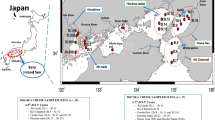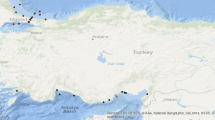Abstract
Tetrabromobisphenol-A (TBBPA) is a typical persistent organic pollutant (POP) that is harmful to the environment and organisms. It easily accumulates in organisms and is transmitted along the food chain or food web for long distances and long periods of time. The experiment was designed to assess the TBBPA pollution levels in marine environments via environmental sample testing and risk assessment. TBBPA levels in seawater and zooplankton samples at each station (n = 38) were detected, whereafter the bioaccumulation factor (BAF) and risk quotient (RQ) were calculated to evaluate the potential bioaccumulation and ecological risk of TBBPA to zooplankton, respectively. The results showed that TBBPA was widely detected in surface seawater and zooplankton samples in the Yellow Sea and Bohai Sea, with levels ranging from ND (non-detected) to 0.46 μg/L and ND to 9.83 μg/kg (wet weight), respectively. In both the Yellow Sea and Bohai Sea, the distance from the shore was one of the main factors affecting the TBBPA concentration in seawater, regardless of visibility. The BAF was significantly correlated with the TBBPA content in zooplankton samples (P < 0.01), which ranged from 372.32 to 29,941.55, indicating that TBBPA exhibits an obvious bioaccumulation risk to marine zooplankton. The ecological risk assessment indicated that TBBPA levels in seawater pose a high ecotoxicity risk to zooplankton (RQ > 1). This finding suggests that both the significant bioaccumulation of TBBPA in marine ecosystems and its potential ecological risks cannot be ignored.




Similar content being viewed by others
Availability of data and material
All data generated or used during the study appear in the submitted article.
Code availability
Not applicable
References
Arias, A. H., Souissi, A., Roussin, M., Ouddane, B., & Souissi, S. (2016). Bioaccumulation of PAHs in marine zooplankton: an experimental study in the copepod Pseudodiaptomus marinus. Environmental Earth Sciences, 75, 691
Barron, M. G. (1990). Bioconcentration will water-borne organic chemicals accumulate in aquatic animals. Environmental Science & Technology, 24, 1612–1618
Chen, X. C., Zhu, L. Y., Huang, Y., Gong, W. J., & Hao, Y. (2017). Community structure of the zooplankton in the Southern Yellow Sea. Marine Sciences, 41(10), 41–49
Chen, X., Zhu, L. Y., Wang, C., Dong, H. H., Shen, Y., & Bu, Y. Q. (2019). Effects of TBBPA on feeding and bioaccumulation of Tigriopus japonicus at different temperatures. Periodical of Ocean University of China, 49(5), 45–53
Deng, J. P., Li, Y., & Pan, L. Q. (2015). The acute Toxicity of TBBPA on seven marine microalgae. Periodical of Ocean University of China, 45(2), 54–59
Gong, W. J., Zhu, L. Y., Hao, Y., Jiang, T. T., & Han, C. (2016). Acute toxicity and oxidative stress of tetrabromobis-phenol A to Eurytemora pacifica. Asian Journal of Ecotoxicology, 11(4), 232–238
Gong, W. J., Zhu, L. Y., Jiang, T. T., & Han, C. (2017). The occurrence and spatial-temporal distribution of tetrabromobisphenol A in the coastal intertidal zone of Qingdao in China, with a focus on toxicity assessment by biological monitoring. Chemosphere, 185, 462–467
Gorga, M., Martínez, E., Ginebreda, A., Eljarrat, E., & Barceló, D. (2013). Determination of PBDEs, HBB, PBEB, DBDPE, HBCD, TBBPA and related compounds in sewage sludge from Catalonia (Spain). Science of the Total Environment, 444, 51–59
Hamelink, J., Landrum, P. F., Bergman, H., & Benson, W. H. (1994). Bioavailability: Physical, chemical, and biological interactions. CRC Press.
Hu, F. X., Pan, L. Q., Xiu, M., Jin, Q., Wang, G. H., & Chao, W. (2015). Bioaccumulation and detoxification responses in the scallop Chlamys farreri exposed to tetrabromobisphenol A (TBBPA). Environmental Toxicology and Pharmacology, 39, 997–1007
Huang, L., Wu, Y., & Zhang, J. (2009). Studies on nutrient relation of aquatic ecosystem using fatty acids. Marine Sciences, 33(3), 93–96
IRIS (Integrated Risk Information System) (2005) US Environmental Protection Agency, Cincinnati, OH. Accessed at: http://www.epa.gov/iris, 9.
Jensen, L. K., Honkanen, J. O., Jæger, I., & Carroll, J. (2012). Bioaccumulation of phenanthrene and benzo [a] pyrene in Calanus finmarchicus. Ecotoxicology and Environmental Safety, 78, 225–231
Jiang, T. T., Zhu, L. Y., Han, C., Wang, C., Bu, Y. Q., & Chen, X. (2018). The study on accumulation of tetrabromobisphenol A in zooplankton of Bohai Sea and Yellow Sea. Periodical of Ocean University of China, 48(5), 51–58
Jin, Y. C., Liu, L. H., Luo, X. L., & Jiao, Y. G. (2010). Progress in study of degradability and ecotoxicology of tetrabromobisphenol A. Journal of MUC (Natural Sciences Edition), 19(2), 5–10
Kelly, B. C., Ikonomou, M. G., Blair, J. D., Morin, A. E., & Gobas, F. A. P. C. (2007). Food web-specific biomagnification of persistent organic pollutants. Science, 317, 236
Labadie, P., Tlili, K., Alliot, F., Bourges, C., Desportes, A., & Chevreuil, M. (2010). Development of analytical procedures for trace-level determination of polybrominated diphenyl ethers and tetrabromobisphenol A in river water and sediment. Analytical and Bioanalytical Chemistry, 396, 865–875
Lee, G. H., Jin, S. W., Kim, S. J., Pham, T. H., Choi, J. H., & Jeong, H. G. (2019). Tetrabromobisphenol A induces MMP-9 expression via NADPH oxidase and the activation of ROS, MAPK, and Akt pathways in human breast cancer MCF-7 cells. Toxicology Research, 35(1), 93–101
Lévy-Bimbot, M., Major, G., Courilleau, D., Blondeau, J. P., & Lévi, Y. (2012). Tetrabromobisphenol-A disrupts thyroid hormone receptor alpha function in vitro: Use of fluorescence polarization to assay corepressor and coactivator peptide binding. Chemosphere, 87(7), 782–788
Li, C. L., & Wang, K. (2002). Feeding ecology progress of the herbivorous copepod. Acta Ecological Sinica, 22(4), 593–596
Lin, Y. S., Cao, W. Q., Zheng, A. R., Li, W. Q., & Chen, Q. H. (2001). Fatty acid composition analysis and their nutrient effects valuation of some pelagic food or ganisms. Journal of Oceanography in Taiwan Strait, 20, 164–169
Liu, A. F., Qu, G. B., Yu, M., Liu, Y. W., Shi, J. B., & Jiang, G. B. (2016). Tetrabromobisphenol-A/S and nine novel analogs in biological samples from the Chinese Bohai Sea: Implications for trophic transfer. Environmental science & technology, 50(8), 4203–4211
Liu, S. M., Zhu, L. Y., Xu, F. F., & Xu, X. F. (2012). Effect of tetrabromobisphenol A on the ingestion, respiration and ammonia excretion of Calanus sinicus. Periodical of Ocean University of China, 42(12), 49–53
Meng, X. Z., Xiang, N., Duan, Y. P., Chen, L., & Zeng, E. Y. (2012). Hexabromocyclododecane in consumer fish from south China: implications for human exposure via dietary intake. Environmental Toxicology and Chemistry, 31, 1424–1431
Morris, S., Allchin, C. R., Zegers, B. N., Haftka, J. J. H., Boon, J. P., Belpaire, C., et al. (2004). Distribution and fate of HBCD and TBBPA brominated flame retardants in North Sea estuaries and aquatic food webs. Environmental science & technology, 38, 5497–5504
Morteza, Z., Ali, M., Leila, K., & Mahmoud, N. (2016). Assessment of concentration, bioaccumulation and sources of polycyclic aromatic hydrocarbons in zooplankton of Chabahar Bay. Marine Pollution Bulletin, 107(1), 408–412
Pittinger, C. A., & Pecquet, A. M. (2018). Review of historical aquatic toxicity and bioconcentration data for the brominated flame retardant tetrabromobisphenol A (TBBPA): effects to fish, invertebrates, algae, and microbial communities. Environmental Science and Pollution Research, 25, 14361–14372
Shen, G. Y., & Shi, B. Z. (2002). Marine Ecology. Science Press.
Sutton, R., Chen, D., Sun, J., Greig, D. J., & Wu, Y. (2019). Characterization of brominated, chlorinated, and phosphate flame retardants in San Francisco Bay, an urban estuary. Science of the Total Environment, 652, 212–223
Tang, B., Zeng, Y. H., Luo, X. J., Zheng, X. B., & Mai, B. X. (2015). Bioaccumulative characteristics of tetrabromobisphenol A and hexabromocyclododecanes in multi-tissues of prey and predator fish from an e-waste site, South China. Environmental Science and Pollution Research, 22, 12011–12017
Thawadi, S. A. (2020). Microplastics and nanoplastics in aquatic environments: Challenges and threats to aquatic organisms. Arabian Journal for Science and Engineering, 45, 4419–4440
Viganò, L., Casatta, N., Farkas, A., Mascolo, G., Roscioli, C., Stefani, F., et al. (2020). Embryo/larval toxicity and transcriptional effects in zebrafish (Danio rerio) exposed to endocrine active riverbed sediments. Environmental Science and Pollution Research, 27, 10729–10747
Wan, B. H. (1987). Survey of pollution prevention research in the Bohai Sea and Yellow Sea. Marine Environmental Science, 6(4), 1–10
Wang, J. Z., Jia, X. W., Gao, S. T., Zeng, X. Y., Li, H. R., Zhou, Z., et al. (2016). Levels and distributions of polybrominated diphenyl ethers, hexabromocyclododecane, and tetrabromobisphenol A in sediments from Taihu Lake China. Environmental Science and Pollution Research, 23(11), 10361–10370
Xiong, J. K., An, T. C., Zhang, C. S., & Li, G. Y. (2015). Pollution profiles and risk assessment of PBDEs and phenolic brominated flame retardants in water environments within a typical electronic waste dismantling region. Environmental Geochemistry and Health, 37, 457–473
Yang, S. W., Xu, F. F., Zheng, B. H., Wu, F. C., & Wang, S. R. (2013). Multibiomarker responses upon exposure to tetrabromobisphenol A in the freshwater fish Carassius auratus. Aquatic Toxicology, 142, 248–256
Yang, T. Y., Yang, S., Meng, W., Gao, T. X., & Zhang, X. M. (2020). Genetic evaluation of Chinese shrimp (Fenneropenaeus chinensis) stock enhancement in the Yellow Sea and Bohai Sea based on mitochondrial DNA control region. Aquaculture International: Journal of the European Aquaculture Society, 28(2).
Zhang, C. Y., Simpson, R. J., Kim, C. M., Warthmann, N., Delhaize, E., Dolan, L., et al. (2018). Do longer root hairs improve phosphorus uptake? Testing the hypothesis with transgenic Brachypodium distachyon lines over-expressing endogenous RSL genes. New Phytologist, 217(4), 1654–1666
Zhang, L., Yun, X., Na, G. S., Chen, T., Zhang, Y. M., Gu, J., et al. (2011). Determination and application of TBBPA in water by high performance liquid chromatography-tandem mass spectrometry. Chinese Journal of Environmental Engineering, 5(5), 1077–1080
Zhang, S. K. (2018). Research on the marine pollution problems, prevention and treatment status and countermeasures of China. Technology Wind, 23, 156
Zhou, Z. Q., & Kong, F. (2010). Chinese marine ecological environment pollution and prevention measures. Ecology and Environment, 30(009), 15–17
Acknowledgments
This study is supported by the Grants of NSFC Cultivation Project of Jining Medical University (No. JYP2018KJ05), the Grants of Medical and Health Technology Development Projects of Shandong province (No. 2017WS224), and the Grants of Research Support Fund for Youth Teachers of Jining Medical College (No. JY2017FY009). We thank Springer Nature Author Service (authorservices.springernature.com/language-editing/) for its linguistic assistance during the preparation of this manuscript.
Funding
This study is supported by the Grants of NSFC Cultivation Project of Jining Medical University (No. JYP2018KJ05), and the Grants of Medical and Health Technology Development Projects of Shandong province (No. 2017WS224), and also supported by the Grants of Research Support Fund for Youth Teachers of Jining Medical College (No. JY2017FY009).
Author information
Authors and Affiliations
Corresponding authors
Ethics declarations
Conflicts of interest
The authors declare that they have no known competing financial interests or personal relationships that could have appeared to influence the work reported in this paper.
Additional information
Publisher's Note
Springer Nature remains neutral with regard to jurisdictional claims in published maps and institutional affiliations.
Supplementary information
Below is the link to the electronic supplementary material.
Rights and permissions
About this article
Cite this article
Gong, W., Wang, J., Cui, W. et al. Distribution characteristics and risk assessment of TBBPA in seawater and zooplankton in northern sea areas, China. Environ Geochem Health 43, 4759–4769 (2021). https://doi.org/10.1007/s10653-021-00948-5
Received:
Accepted:
Published:
Issue Date:
DOI: https://doi.org/10.1007/s10653-021-00948-5




